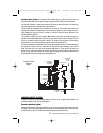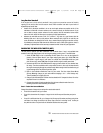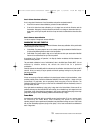
11
Edelbrock Performer Series Carburetor Owner’s Manual 9/01
Changing Components
Metering Rod and Step-Up Spring changes can typically be made in less than five minutes and
without removing the carburetor. First, loosen the Step-Up Piston Cover Screws (See pg. 32) and twist
the Step-Up Piston Cover Plates to the side. The Metering Rods and Step-Up Springs can now be
removed and replaced if necessary. Be sure to replace the Step-Up Piston Cover Plate and tighten the
Step-Up Piston Cover Screw when finished. CAUTION: Do not overtighten the Step-Up Piston
Cover Screws! They should only be tightened to 12 to 17 inch/pounds. Excessive torque will
weaken or snap off the screw heads. If this happens, they may fall into the carb causing serious
engine damage. If an inch/pound torque wrench is not available, snug the screw until it just touches
the plate, then tighten 1/16th turn more.
To replace the Primary or Secondary Metering Jets, first, remove the Metering Rods and Step-Up
Springs as outlined in the preceding paragraph. Next, disconnect the Choke Cam Connector Rod,
Pump Connector Rod, and Choke Connector Rod (when applicable). Finally, remove the 8 Airhorn
Attaching Screws and remove the Airhorn from the carburetor body. A standard screwdriver can now
be used to remove the appropriate Metering Jets. Once desired Metering Jets have been installed the
carb may be reassembled by reversing this procedure.
IDLE MIXTURE
The Edelbrock Performer Series carburetor has conventional Idle Mixture Screws (IMS) that provide a
leaner A/F when turned clockwise and richer A/F when turned counter clockwise. The idle air flow is
controlled by a conventional screw that opens the Primary Throttles. The following procedure should
be used to set the idle mixture and speeds.
1. Fully warm engine and ensure choke is fully open.
2. Air cleaner in place.
3. Set desired speed with the air screw.
4. Adjust the IMS on ONE side to get the maximum possible RPM. Do not go rich
beyond the maximum speed point.
5. If the above changed the idle speed more than 40 RPM, then readjust the speed.
6. Adjust the side OPPOSITE of that in Step 4 to get maximum RPM.
7. Reset the speed.
8. Carefully trim each IMS to again get the maximum idle RPM.
9. Go leaner just enough to get a 20 RPM drop in speed.
10. Reset the speed to the desired RPM.
11. This is a Lean-Best Idle Set. Setting richer than this will not improve idle quality or
performance, but could tend to foul plugs.
Winter Fuel Idle Sets
During the winter months (in most parts of the country) the local fuel will be a “winter” blend that is
very volatile, as an assist to cold-engine starting and driveability during warm-up. However, the high
volatility has the disadvantage of allowing excessive vaporization of the fuel if the vehicle is operated
in a heated area such as a garage. This can result in problems in the idle-set procedures since the
carburetor’s internal vents will allow this excess vapor to be drawn into the throats and enrichen the
mixture. The idle will be erratic and not seem to be able to hold a set. To resolve this type of problem,
it is advisable to perform the final settings outdoors after the vehicle has been stabilized with a drive
of several miles.
1403-1413 Perf Series Carburetor Owner's Manual.qxd 3/31/2006 12:04 PM Page 11


















